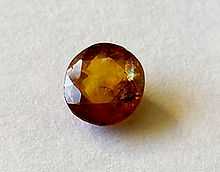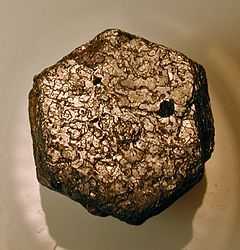Hibonite
| Hibonite | |
|---|---|
|
Hibonite, 1.6 cm sharp and lustrous crystal from Esiva eluvials, Maromby Commune, Amboasary District, Anosy (Fort Dauphin) Region, Tuléar (Toliara) Province, Madagascar | |
| General | |
| Category | Oxide minerals |
| Formula (repeating unit) | (Ca,Ce)(Al,Ti,Mg)12O19 |
| Strunz classification | 04.CC.45 |
| Crystal symmetry |
Hexagonal dihexagonal dipyramidal H-M symbol: (6/m 2/m 2/m) Space group: P 63/mmc |
| Unit cell | a = 5.56 Å, c = 21.89 Å; Z=2 |
| Identification | |
| Color | Brownish black to black; reddish brown in thin fragments; blue in meteorite occurrence |
| Crystal habit | Prismatic platy to steep pyramidal crystals |
| Crystal system | Hexagonal |
| Cleavage | {0001} good, {1010} parting |
| Fracture | Subconchoidal |
| Mohs scale hardness | 7½-8 |
| Luster | Vitreous |
| Streak | reddish brown |
| Diaphaneity | Semitransparent |
| Specific gravity | 3.84 |
| Optical properties | Uniaxial (-) |
| Refractive index | nω = 1.807(2), nε = 1.79(1) |
| Pleochroism | O = brownish gray; E = gray |
| References | [1][2] |
Hibonite ((Ca,Ce)(Al,Ti,Mg)12O19) is a brownish black mineral with a hardness of 7.5-8.0 and a hexagonal crystal structure. It is rare, but is found in high-grade metamorphic rocks on Madagascar. Some presolar grains in primitive meteorites consist of hibonite. Hibonite also is a common mineral in the Ca-Al-rich inclusions (CAIs) found in some chondritic meteorites. Hibonite is closely related to hibonite-Fe (IMA 2009-027, ((Fe,Mg)Al12O19)) an alteration mineral from the Allende meteorite.[3]

Faceted hibonite, 0.40 ct, Mogok, Myanmar
A very rare gem, Hibonite was discovered in Madagascar by Paul Hibon, a French prospector.[4]
See also
References
| Wikimedia Commons has media related to Hibonite. |
| ||||||||||||||||||||||||||||||||||||||||||||||||||||||||||||
